The research is in and it validates what PCG has been recommending clients over the past 30 years.
“Workplace design must involve all key stakeholders to achieve an environment which enables employees to interact and collaborate as well as have space for quiet contemplation, which ultimately ensures productivity.”
If your company is considering a workplace change or relocation strategy, the following nine myths are a must read;Myth 1: The Majority of Contact in the Workplace is Planned
Only 34% of all employee interaction occurs in a planned way.
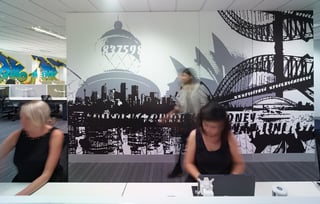 Most interaction is spontaneous and will most likely happen around an employee’s desk. Therefore, workplace design needs to allow for easy interaction and spontaneity, not impede it or only focus on spaces for planned interaction.
Most interaction is spontaneous and will most likely happen around an employee’s desk. Therefore, workplace design needs to allow for easy interaction and spontaneity, not impede it or only focus on spaces for planned interaction.
Myth 2: People Work Alone
 While most employees probably feel they work alone it can be said the majority of work tasks are completed in collaboration with colleagues. ‘Data captured from observing more than 200,000 instances of behaviour in 17 different organisations shows that on average 34 % of all people present in the space are interacting face-to-face at any one point in time.’
While most employees probably feel they work alone it can be said the majority of work tasks are completed in collaboration with colleagues. ‘Data captured from observing more than 200,000 instances of behaviour in 17 different organisations shows that on average 34 % of all people present in the space are interacting face-to-face at any one point in time.’
Myth 3: Open Plan Offices Equal More Interaction
In the current work environment, most businesses like to think of themselves as flexible, however, most are still extremely static. ‘On average, only 6% of people are on the move at any one point in time whilst 85% are sitting.’
Research also found that when employees do interact face to face it’s mostly with people close by. ‘Data from 16 organisations shows ‘on average 78% of ties span between people on the same floor.’
This suggests ‘out of sight’ means ‘out of mind’ which impacts collaboration between employees. (You may also like our blog: office design truths: beyond 50m co-workers may as well be on the moon >)
Myth 4: Corridor Conversations Contribute to Productivity
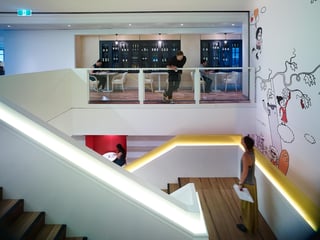
Despite common perceptions that interactions tend to take place in corridors or at the ‘water cooler,’ ‘observational data of 24 buildings shows only 4% of interactions occur in corridors.’
Interactions mostly occur in:
50% take place in workspaces
38% happen in meeting rooms
9% in shared facilities such as kitchens, tea points, canteens or around the water-cooler.
Myth 5: Email Overcomes Physical Distance
With current communication technologies, it’s thought that physical distance no longer matters. (Cairncross 1997) However, ‘studies of five different organisations revealed we email the people we meet face-to-face more frequently, with a 77-89% match between face-to-face and email contact.’
'The match between:
Email and unplanned face-to-face contact was 83-89%
Email and planned face-to-face contact was 77-84%'
It’s thought unplanned contact is spatially driven, so the higher overlap between unplanned and email contact highlights how closely email patterns are tied to physical space.
Myth 6: Desks are Occupied 68% of the Time
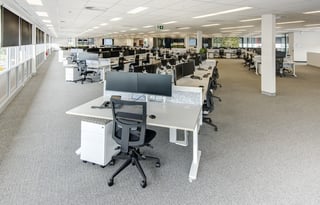 Research from observing ‘over 16,000 desks in more than 30 different organisations with a fixed desk for every employee, shows only 44% of desks are occupied at any one point in time.’
Research from observing ‘over 16,000 desks in more than 30 different organisations with a fixed desk for every employee, shows only 44% of desks are occupied at any one point in time.’
‘On average perceived occupancy was 68% – typically 25-30% higher than actual occupancy figures.’
This data suggests Activity Based Working with more shared facilities are needed to encourage employees to interact and work more effectively.
Myth 7: Meeting Rooms are Always Booked
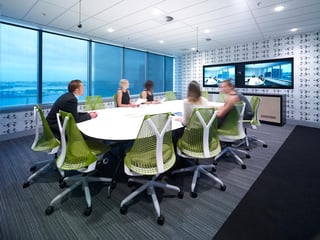 A daily grievance at many workplaces is a lack of available meeting rooms. However, research has shown, ‘average meeting room occupancy across 24 organisations shows a 38% utilisation rate.’ This difference between perceptions and actual occupancy is said to be because ‘bookings don’t take place at all or are shorter than anticipated and the popularity of certain preferred time slots for meetings (10-12 and 2-4pm).’
A daily grievance at many workplaces is a lack of available meeting rooms. However, research has shown, ‘average meeting room occupancy across 24 organisations shows a 38% utilisation rate.’ This difference between perceptions and actual occupancy is said to be because ‘bookings don’t take place at all or are shorter than anticipated and the popularity of certain preferred time slots for meetings (10-12 and 2-4pm).’
Myth 8: Workplaces Enable Concentrated Work
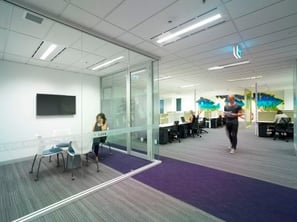
‘Data from five organisations and based on more than 2,000 responses, found that only 35% of people felt their workspace supported concentrated and silent work, while on average 41% disagreed.
As previously mentioned a great workplace design will accommodate both collaboration and quiet areas for when employees need to concentrate and get their work done.
Myth 9: Workplaces Reflect the Organisations Brand and Values
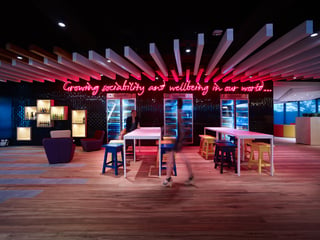 'Results from studies in four different organisations highlighted the fact that most organisations have a long way to go when it comes to a workplace that strongly reflects the company’s values – on average only 11-15% of staff strongly agreed that their workplace reflected the identity of the company.'
'Results from studies in four different organisations highlighted the fact that most organisations have a long way to go when it comes to a workplace that strongly reflects the company’s values – on average only 11-15% of staff strongly agreed that their workplace reflected the identity of the company.'
‘The majority reported that their space was bland, neutral and faceless and when asked whether any aspect of the space represented what the company stood for, most said no.’
An enlightened workplace design strategy must include multiple areas that allow for interaction and collaboration as well as quiet contemplation. The overall result will enable an organisation which looks different, feels different and most importantly behaves differently. Only then, can the property and workplace become an extension of the brand, enable cultural change, and reinforce the true DNA of the business and its purpose.
Take advantage of the opportunity to have a Master Plan prepared, before you make your next big workplace decision. It allows business leaders to develop and implement a clear property and facilities strategy. For more information download our Master Planning Brochure
Acknowledgements
* Insight Newsletter, August 9, 2016
* Dr Kerstin Saile, Bartlett School of Architecture & Ros Pomeroy & Rosie Haslem of Spacelab UK
* Steelcase (2015), ‘The Privacy Crisis. Taking a Toll on Employee Engagement’, (Issue 68; Grand Rapids, Michigan: Steelcase).
* Cairncross, Frances (1997), The Death of Distance: How the Communications Revolution Will Change Our Lives (Cambrige/MA: Harvard University Press).










Share your thoughts